A small portion of consumers are loyal when it comes to brands, but there is a larger chunk who are swayed aIway by many other factors, packaging design among them is one, Kaunain Shahidi of Packaging MEA finds out

Imagine yourself walking down the aisle of a supermarket looking for your favourite brand on the shelf, and yes you can see that it’s halfway down the aisle to your right. Great, got it, here is my brand. Oh, what’s that? Something new and it looks interesting; you find some other brand of a similar product and get attracted. Research shows that approximately only 30% of consumers are loyal to their favourite brands while the other 70% can be swayed by a number of factors, especially packaging. Research also shows that if, as a consumer you look at the product on the shelf for more than three seconds, there is 60% probability that you might buy the product even though you had never any intention of doing so.
You might have noticed that the shopping list made at home never tallies exactly with what ends up in the trolleys at the supermarket the grocery store. That’s because for most of us shopping experience happens at the subconscious level and it is primarily, packaging, which drives the buying decisions.
The brand battle
In today’s competitive markets, all brands are battling to get noticed while consumers are bombarded with plenty of options. There are choices everywhere including online shopping, which is one of the fastest growing modes of buying. In general, whether strolling through a store or surfing the web, packaging is often the first thing the consumer notices and examines as they shop, and it certainly plays a key role in the consumer decision-making process.
Packaging acts as a visual signpost, triggering automatic and unconscious shortcuts we all use when shopping. Every element of packaging nudges us to make choices while buying. We succumb to instinct and default to the familiar as we walk down the aisles. As human beings we are hard-wired to look for the so-called shortcuts and make irrational decisions time and again while shopping.
Connecting at the emotional level
Over the years, consumer habits have changed rapidly, they are less likely to make purchase decisions based on just brand loyalty; there are many other ‘emotional’ factors that come into play. This change in consumer habits has made packaging transition from ‘conservation’ to ‘communication’. Mastering the ‘unboxing experience’ is a new age term and a new perspective of packaging design. Product positioning is required to ensure greater shelf space and impact so that it aligns completely with the decision-making and human reasoning in a scientific manner.
A thorough scientific study on how we make decisions and why we choose to buy certain products must be the focus of the brand owners. It is certainly very important to know how exactly a specific consumer segment processes information and how they are influenced to behave.
Studies reflect that shopping decisions are largely driven by what people see as they navigate through cluttered aisles and how packs initially attract them with instinctive feeling prior to reading any on-pack message. Most of the choices consumers make are purely instinctive. Before logic has the chance to come into play, decisions have been made based on various factors, primarily colour, shape, images and texture.
The impact of packaging elements
The first thing that consumers remember about a brand is its colour. However, the impact that colours have on human emotions may differ from person to person depending on various factors such as age, gender and cultural contexts. Understanding the psychology of colours in branding is very important to have a greater shelf impact; Research has found that people make a subconscious judgment about products within the first 90 seconds of seeing it. As with colour, people associate different shapes with a variety of emotions and other qualities. This makes it important to choose the perfect shape/association for the product. The shape of the package conveys an implicit association with the product nature and brand personality, and it powerfully affects how people experience the brand and the product. The right shape must be selected through proper research. Images and texture are also bio-motive trigger elements that conjure instinctive responses from the consumer, which must be taken care with all seriousness.
Other than the basics of design elements to get the attention of the consumers, scientific study through packaging design must be used to influence the consumers to buy the products. Online retailers use such techniques and are aware of your preferences based on previous purchases so they suggest products that you’re expected to like. They generate suggestions that nudge you in the direction of your preferences and likes. Package design elements and supermarket shelves can also employ similar tactics.
It has been observed that the average large supermarket has 40,000 product lines. You buy on an average 40 products per trip in a shopping that lasts for 30 minutes. This means that you need to reject 20 products per second which one cannot do consciously. Thus we rely largely on unconscious processes to guide our buying behaviour. In this context below are five factors that must be considered for successful packaging designs.

1. Keep it simple: In crowded aisles, the simple, minimalist and uncluttered designs are the most effective. Moments of auditory and visually calm designs magnetically attract consumers as in the sea of over-information consumers get disrupted through a minimalist approach. All design elements including void space, must be synergistically represented in the simplest but aesthetic way. Psychological triggers while choosing the images should be considered. For example, curves and round shapes communicate softness, sensuality and playfulness; while squares or thick lines, communicate masculinity, sharpness and stability.

2. Stand out: Bold and loud colours, big logo size or brand name is not the smart way of standing out on the shelves. The human brain is a pattern recognition machine and we seek out familiar patterns inherent in our own nature. The design elements must be based on the golden mean ratio related to the brand personality and product characteristics keeping in mind the target consumers.

3. Engage emotionally: Consumer acts when there is some feeling while looking at the products on the shelf. When someone looks at you, you are compelled to look back to determine the nature of attraction. The package must have design elements to engage consumers emotionally as our brains instinctively look for patterns that signal safety or harm, pain or pleasure and there is nothing more powerful than eye contact.

4. Be Iconic: Use of ‘Design Thinking’ tool can make the packaging meaningful and memorable hence iconic across the marketing communication. This can be achieved through unique shape, colour, logo and typography. The iconic packaging designs instantly help one to connect with the brand by easily recalling the brand attributes.

5. Go Green: Consumers are becoming more aware and conscious about the limited resource availability to produce packaging and there is a trend towards choosing green packaging, especially among millennials and the Arab digital generation. Going green with the packaging associates the brand with a noble cause many people to believe in. A global study found that approximately 55% of consumers are willing to pay more for companies that are committed to a positive, social and environmental impact.
Research reflects that attractive packaging design motivates people to make impulsive choices, bypasses reflective thought and leaves the purchaser with a feeling of having been rewarded. That’s a powerful impact of packaging. Since most of the buying decisions are very impulsive and intuitive, all packaging design elements must be chosen accordingly to make the packaging stand out and grab the attention of the consumers. It is high time to dive beneath the surface and think beyond rational claims in developing packaging for the launch of new products.
Design thinking and behavioural science can be very effectively used to create great packaging designs and the future is where consumer-shopping minds can be understood, and packaging can be designed to maximise financial performance.



